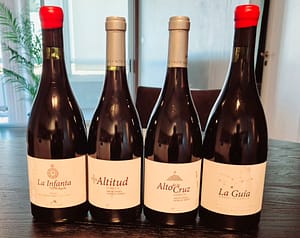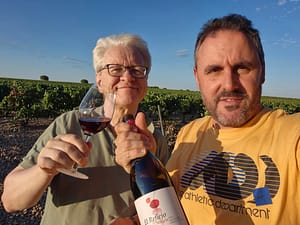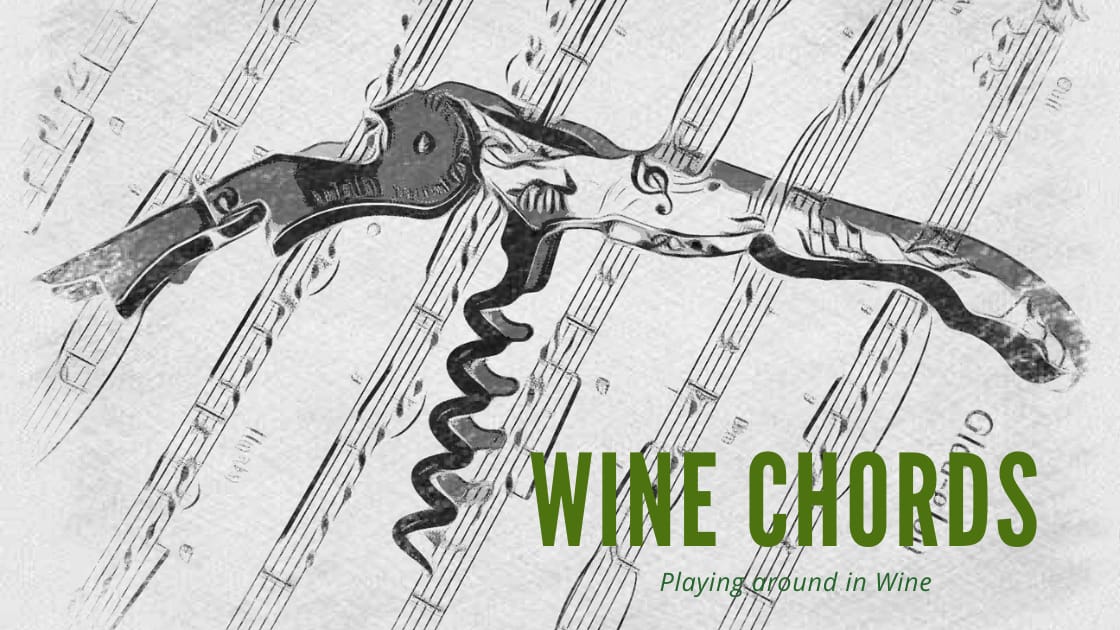Aurelio García is one of the most attentive and thoughtful voices in modern Central Spanish wine. Together with his partner, Micaela Rubio, he works across three regions—Cuenca, Ávila, and Soria—always with a focus on old vineyards, native varieties, and minimal intervention. His wines are precise, expressive, and deeply rooted in place.

When a case from Aurelio García arrived in the post, two bottles had sadly broken in transit. Still, four remained intact—and with those, I took the opportunity to gather my wine club for a focused tasting. We added a few complementary wines for context, but the stars of the evening were clearly Aurelio’s own: La Infanta, +Altitud, Alto de la Cruz, and La Guía. Though we missed out on El Reflejo and Mikaela, the tasting offered a vivid insight into Aurelio’s style across three distinct regions.

La Infanta 2021 – Cuenca
Cuenca here refers to the Ribera del Júcar zone, though Aurelio prefers not to label his wines under the DO, opting for greater freedom. La Infanta comes from a single parcel in Casas de Benítez and is made from 60% bobal and 40% co-planted local varieties.
Delicate and complex, it showed dark berry fruit (dark cherry and plum) on the nose, along with herbal notes, a hint of tar, and a taut, mineral texture. A slightly bitter aftertaste added grip. There was a quiet power to it—restrained, yet full of energy.
+Altitud 2021 – Ávila
A village wine from the granite soils of Navatalgordo in the Sierra de Gredos.
Light in colour and body, almost ethereal, it offered notes of raspberry, wild strawberry, and flowers, with a fine, lacy texture. This was the most immediately charming wine of the tasting, with several tasters noting its vibrant fruit and finesse.
Alto de la Cruz 2022 – Ávila
Also from Navatalgordo, but from a cooler, north-facing valley.
Though paler in colour, this wine showed more structure and depth. It opened with herbal tones, redcurrant and floral aromatics, then narrowed into a vertical, mineral finish. There was more volume here, likely from clay soils, with fine-grained tannins and underlying tension.

La Guía 2021 – Soria
From Matanza de Soria, a high-altitude village in the eastern part of Ribera del Duero.
A blend of tinto fino (tempranillo) and albillo mayor from pre-phylloxera vines, it combined red and dark fruits with floral lift and a subtle hint of nuts. Velvety on the palate, cool and juicy at the core—it struck a fine balance between seriousness and drinkability. For me, this was the most complete wine of the night: subtle, savoury, and quietly profound. Meanwhile, +Altitud stood out for sheer charm and drinkability.
While La Infanta and La Guía come in serious bottles with serious price tags, the wines from Gredos are outstanding value for money.
What We Missed
We didn’t get to taste El Reflejo or Mikaela, but here’s what they might have brought to the table:
El Reflejo is Aurelio’s village wine from Cuenca—a blend of bobal and co-planted varieties from around 25 parcels. Fruit-driven and supple, it offers dark and red berries, with freshness and an approachable style.
Mikaela, named after his wife and winemaking partner, is a paraje wine from deeper, pebble-rich soils. Made with whole clusters and aged in foudres, it shows juicy, concentrated fruit with a mineral streak—lively and taut.

Each wine carried the mark of its place, but all shared a sense of purity, restraint, and precision. Interestingly, my fellow tasters had no difficulty identifying which of the three regions each wine came from—even though the wines were, of course, tasted blind. That in itself is a mark of quality, and a testament to the clarity of Aurelio García’s site expression. Even in the absence of the two missing bottles, the tasting was a clear reminder that Aurelio García is crafting some of Spain’s most thoughtful and terroir-driven wines.
Leave a Comment
















